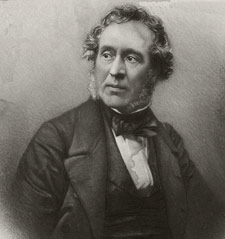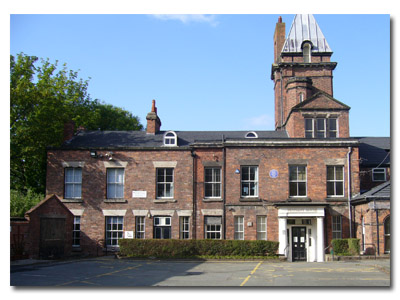The Early Years
Joseph Mayer was born on 23rd February 1803 in Newcastle-under-Lyme, Staffordshire. He was born into a relatively wealthy family and was one of eleven children, ten of whom survived into adulthood. His father, Samuel, was a landowner who had a tanning business, which provided leather goods to the industries and inhabitants of the Potteries area.
In 1820, Joseph Mayer’s elder sister, Eliza, married James Wordley of Liverpool. Two years later, Joseph Mayer moved to Liverpool to work as an assistant in James Wordley’s silversmith and jewellery business.
Liverpool was the main port for the Potteries; the Trent-Mersey Canal providing the means for transporting the china clay and other raw materials to the Potteries and the finished goods to the rest of the country and beyond. Business opportunities were good, with Liverpool’s growing importance as a port, and Britain’s increasing trade with the Empire and America.
The Liverpool Years

By the mid 1830s, Joseph Mayer was in partnership with his brother-in-law, James Wordley, with their business premises at 62 Lord Street, Liverpool. As his sister’s family grew, he moved out of their home, and lived briefly in Queen Street, Edge Hill, before moving to Clarence Terrace, Everton Road.
During these early years, Joseph Mayer appears to have involved himself in the cultural life of Liverpool, and started to develop his interest as a collector of antiquities. He travelled abroad for the first time in1828, and these business interests continued to draw him to Europe over the following decades. It was on these trips that his enthusiasm for antiquities was nurtured. He would acquire items for the business as well as for his own collection.
By 1844 he had set up his own business at 68 Lord Street, where he was to live above these premises for a number of years. Whereas James Wordley traded in bought-in jewellery and silverware, Joseph Mayer’s business embraced the design, manufacture and trading of jewellery, engraving, and gold and silver plating. He would find inspiration for the design of his own jewellery from his collection of antiquities
His status as a collector was growing through his purchases both in Britain and abroad. Locally he took a particular interest in the finds being made just a few miles from his home, at Meols at the mouth of the River Dee. In 1848, Joseph Mayer, Henry Pigeon and the Rev. Abraham Hume agreed the final plans for the establishment of the Historic Society of Lancashire and Cheshire. This led to Joseph Mayer’s involvement with collectors in London, and to his subsequent election as Fellow of the Society of Antiquaries in1850. In that same year he joined the British Archaeological Association, and over the next few years he was to join many similar bodies across Europe.
His business was very successful by the1850s, and he was able to devote himself more fully to his passion for antiquities and the promotion of learning. He was enthused by the contents of the British Museum, particularly its Egyptian displays, which inspired him to open his own Egyptian Museum in Colquitt Street, Liverpool in 1852. He added to the displays over the following years so that by 1862 it had become known as the ‘Museum of Antiquities’, and contained a considerable range of relics, artefacts and manuscripts.
His collection continued to grow as he made further individual purchases, as well as acquiring certain collections which came onto the market, including:
- The Faussett Collection of Anglo-Saxon antiquities
- The Fejervary Collection of ivories and prehistoric metalwork
- The Hertz Collection of gems
- W H Rolfe’s Collection of Anglo-Saxon antiquities.
By 1867, his museum collection totalled 15,000 items. However, in1860, the newly- constructed Liverpool Museum was opened. Its construction was funded by the successful merchant banker, William Brown, to be managed by the Liverpool Town Council. In 1867, Joseph Mayer gifted his museum collection to the Council, where it subsequently formed a substantial part of Liverpool Museum’s collection (now known as the World Museum, Liverpool).
The Bebington Years
By the late 1850s, Joseph Mayer had moved residence to Wirral, living briefly at Dacre Park, Rock Ferry, before moving to the house he had bought in Bebington. He named this house ‘Pennant House’, after Thomas Pennant, the traveller and naturalist.

At this time, the economic importance of Liverpool, the opening of the railways, the construction of the New Chester Road and the introduction of steam ferryboats on the Mersey, all led to the growth of Bebington village as a dormitory township for many professional and business people working in Liverpool.
Joseph Mayer quickly immersed himself into village life, which had the effect of transforming and enriching the lives of the community. He was instrumental in bringing gas and water services to the village; he was involved in founding clubs for various sports and recreational activities; he raised funds for a village hospital and a horticultural society, and allotments were formed on his initiative.
In 1864 he financed the raising and clothing of volunteers to form a company of the 4th Cheshire Rifles, for which Mayer served as commander for nearly ten years.
Joseph Mayer’s enthusiasm for people to enrich their lives, through access to learning and culture, led him to establish a free library in Bebington in 1866. Initially, he established the library in Thomas Francis’s old house which he had bought, but the demand for these facilities soon outgrew the original library premises.
Fortunately in 1869, the farmhouse, barn and associated buildings, together with five acres of land which adjoined Pennant House, came up for sale, so Joseph Mayer bought them. He immediately set to work, and within a few months, had created public parkland from the farmland and orchard that had previously existed.
He then converted and extended the farmhouse, including the addition of a clock tower, to provide a new and bigger home for the library, which was opened in 1870. It was a facility enjoyed by all, from children to the elderly, from the poorest farm labourers to the wealthiest businessmen.

He then turned his attention to the barn, and by 1871 had it converted into a single storey public hall to be used for exhibitions and lectures. By 1873, the year of his retirement from his jewellers business, he commissioned plans for the extension of Pennant House, to better accommodate his ever-growing collection of manuscripts, papers, pictures and sculptures.
Despite these extensions, conditions in Pennant House were becoming too cramped for his collection, so by 1878 he decided to demolish the ‘barn’ and construct a new two storey hall. The ground floor would provide for lectures and concerts, and the upper floor would be a gallery in which to exhibit his collection of pictures and sculptures.
A local newspaper in 1878 reported:
… without losing its rustic air, the village of Bebington gained advantages such as many might envy in convenience and comfort. A very few years since the place had neither gas nor pavements, its younger population went barefooted and women fetched water from a well as much as two miles distance. If all that is changed, and if Bebington is to be held up as a model village, the honour is due to Joseph Mayer.
The upkeep of the library, hall and parkland was being met totally by Joseph Mayer, but in looking to the future, he decided to establish the Mayer Trust in 1878 to undertake these tasks. He continued to provide the necessary funds to the Trust, which comprised of himself and four friends. He chaired the Trust up to his death in 1886. He is buried in the graveyard of St Andrew’s Church in Bebington.
Joseph Mayer – The Legacy
Joseph Mayer never married, and he shared his home at Pennant House with his unmarried sister Jane, and niece Mary Wordley. Upon his death in 1886, his will provided for his estate to be shared between his sisters, certain relatives and also the Mayer Trust
He bequeathed sculptures, paintings, medallions and other articles to the Trust for display in the museum gallery. However, his papers, pictures and gems, some 20,000 items, were to be sold, to provide the funds towards executing the financial provisions in his will. These were offered to Liverpool Museum for £6000, but the offer was declined, and they were subsequently auctioned at Sotheby’s and by a Liverpool auctioneer.

The bequest made to the Mayer Trust soon proved to be insufficient to generate the income needed to meet all of the Trust’s running costs, and by 1894, the local council started to contribute towards the costs of the free library. Eventually in 1930, the council took on the full responsibility for the library, hall, museum and parkland, but the Trust retained the responsibility for the annual lectures, which are still provided today.
With the opening of Bebington Civic Centre in the early 1970s the library services were transferred to this new building. The Mayer Library building is now vacant. The parkland continues to be maintained by the local authority and retains the name ‘Mayer Park’; the hall, known as ‘Mayer Hall’, is still in restricted community use but its future, and that of the Library building and Pennant House, is uncertain, as the local council seeks changes to the management arrangements of these buildings.
Joseph Mayer, during his earlier collecting years, showed particular interest in British archaeology, when little interest was being shown by the British Museum and parts of the archaeological establishment. His interest and support for those pursuing such researches and investigations, and his purchase of Anglo-Saxon antiquaries, helped in the development of British archaeology.
His gift to Liverpool Museum in 1867 was and is identified, as the ‘Mayer Collection’. However, a more visible reminder of the significance of Joseph Mayer can be found inside St Georges Hall, Liverpool. Following his gift to the Museum, Liverpool Town Council commissioned a marble statue of Joseph Mayer, sculpted by Giovanni Fontana, which was unveiled in 1869. This statue is one of twelve statues inside St Georges Hall; of prominent men judged to be of importance to the people of Liverpool, a measure of the esteem in which Joseph Mayer was held during his lifetime.
English Heritage currently operate the Blue Plaque scheme which commemorates the former homes or workplaces of famous people.
The scheme has been in being since the mid nineteenth century but only applied to the Greater London area. However in 1999 they announced that for the first time, they were extending the scheme to other parts of the country. The first area selected for the Plaques was Liverpool/Merseyside. Fifteen individuals were identified who merited recognition for their contribution to society.
One of those was Joseph Mayer, and a Blue Plaque was affixed to the front of Pennant House a few months later:
a recognition, more than a century after his death, of his lasting contribution to society.
Acknowledgements are made to:
- The Society of Antiquaries, whose publication ‘Joseph Mayer of Liverpool 1803-1886’ provided much of the background information for the above.
- Liverpool Museum, for the provision of the picture of the ancient Egyptian coffin.
- St George’s Hall for facilitating the photographing of Joseph Mayer’s statue.
